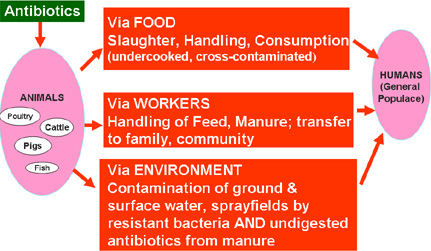- Fitness (19)
- News & Reviews (25)
- Nutrition (20)
- Science (10)
- Supplements (6)
- Technologies (8)
- The Arts (9)
Antibacterial Personal Care Products Are Linked to Allergies in Children
June 20th, 2012
 From Science Daily (June 19, 2012) This study gives us yet another reason to use more natural products! Cathie— Exposure to common antibacterial chemicals and preservatives found in soap, toothpaste, mouthwash and other personal-care products may make children more prone to a wide range of food and environmental allergies, according to new research from Johns Hopkins Children’s Center. Results of the NIH-funded study are published online ahead of print June 18 in the Journal of Allergy and Clinical Immunology.
From Science Daily (June 19, 2012) This study gives us yet another reason to use more natural products! Cathie— Exposure to common antibacterial chemicals and preservatives found in soap, toothpaste, mouthwash and other personal-care products may make children more prone to a wide range of food and environmental allergies, according to new research from Johns Hopkins Children’s Center. Results of the NIH-funded study are published online ahead of print June 18 in the Journal of Allergy and Clinical Immunology.
Using existing data from a national health survey of 860 children ages 6 to 18, Johns Hopkins researchers examined the relationship between a child’s urinary levels of antibacterials and preservatives found in many personal-hygiene products and the presence of IgE antibodies in the child’s blood. IgE antibodies are immune chemicals that rise in response to an allergen and are markedly elevated in people with allergies.
“We saw a link between level of exposure, measured by the amount of antimicrobial agents in the urine, and allergy risk, indicated by circulating antibodies to specific allergens,” said lead investigator Jessica Savage, M.D., M.H.S., an allergy and immunology fellow at Hopkins. Continue reading »
Little Bit of Exercise, Big Benefits
October 6th, 2011
 ScienceDaily: A new University of Colorado Boulder study shows that a small amount of physical exercise could profoundly protect the elderly from long-term memory loss that can happen suddenly following infection, illnesses or injury in old age.
ScienceDaily: A new University of Colorado Boulder study shows that a small amount of physical exercise could profoundly protect the elderly from long-term memory loss that can happen suddenly following infection, illnesses or injury in old age.
In the study, CU-Boulder Research Associate Ruth Barrientos and her colleagues showed that aging rats that ran just over half a kilometer each week were protected against infection-induced memory loss.
“Our research shows that a small amount of physical exercise by late middle-aged rats profoundly protects against exaggerated inflammation in the brain and long-lasting memory impairments that follow a serious bacterial infection,” said Barrientos of the psychology and neuroscience department.
“Strikingly, this small amount of running was sufficient to confer robust benefits for those that ran over those that did not run,” Barrientos said. “This is an important finding because those of advanced age are more vulnerable to memory impairments following immune challenges such as bacterial infections or surgery. With baby boomers currently at retirement age, the risk of diminished memory function in this population is of great concern. Thus, effective noninvasive therapies are of substantial clinical value.”
Filed under Fitness | Comments Off on Little Bit of Exercise, Big BenefitsAntibiotic Resistance
September 16th, 2011

A Report from the Physicians Committee for Responsible Medicine: The growing public health threat of antibiotic resistance is almost entirely attributed to antimicrobial use in animal agriculture.
Animals raised for meat and dairy products are routinely treated with antibiotics to promote growth and reduce the risk of illnesses that would otherwise be common in crowded living conditions. Currently, 80 percent of antibiotics used in the United States are administered to animals on farms.
Widespread use of antibiotics can give rise to resistant bacteria, which may or may not cause disease in the animals. Through contact with farm workers and contaminated waste runoff, resistant bacteria can spread to humans and to other animals.
Bacteria can also transfer resistance traits to other strains and classes of bacteria.
So the fewer antibiotics we consume on a daily basis through animal products, the healthier we’ll be! — Cathie
Filed under Science | Comments Off on Antibiotic ResistanceApples & Onions & Pesticides
June 14th, 2011
 By Scott Hensley for NPR: Maybe you overlooked the U.S. Department of Agriculture’s yearly roundup of pesticides in foods released last month. It’s long and full of tongue-twisting chemicals — like tetrahdrophthalimide and pyraclostrobin — found on some popular produce.
By Scott Hensley for NPR: Maybe you overlooked the U.S. Department of Agriculture’s yearly roundup of pesticides in foods released last month. It’s long and full of tongue-twisting chemicals — like tetrahdrophthalimide and pyraclostrobin — found on some popular produce.
But the Environmental Working Group, an advocate for stricter pesticide controls, has crunched the numbers from that report and a bunch of others to come up with a guide for concerned shoppers.
There’s a “Dirty Dozen,” headlined by apples, celery and strawberries. And there’s also a catchy “Clean 15” of fruits and vegetables lowest in pesticides. The top three on that list: onions, sweet corn and pineapples.
The EWG suggests that people buy organically grown fruits and vegetables for the varieties on its list of the most likely to carry pesticide residues. But the group also says the health benefits from produce mean that “eating conventionally-grown produce is far better than not eating fruits and vegetables at all.” Continue reading »
Gut Bacteria: the New Blood Type
April 21st, 2011
 By Carl Zimmer, New York Times: In the early 1900s, scientists discovered that each person belonged to one of four blood types. Now they have discovered a new way to classify humanity: by bacteria.
By Carl Zimmer, New York Times: In the early 1900s, scientists discovered that each person belonged to one of four blood types. Now they have discovered a new way to classify humanity: by bacteria.
Each human being is host to thousands of different species of microbes. Yet a group of scientists now report just three distinct ecosystems in the guts of people they have studied….The microbes alter the gut so that only certain species can follow them.
Whatever the cause of the different enterotypes, they may end up having discrete effects on people’s health. Gut microbes aid in food digestion and synthesize vitamins, using enzymes our own cells cannot make.
Dr. Bork and his colleagues have found that each of the types makes a unique balance of these enzymes. Enterotype 1 produces more enzymes for making vitamin B7 (also known as biotin), for example, and Enterotype 2 more enzymes for vitamin B1 (thiamine).
The discovery of the blood types A, B, AB and O had a major effect on how doctors practice medicine. They could limit the chances that a patient’s body would reject a blood transfusion by making sure the donated blood was of a matching type. The discovery of enterotypes could someday lead to medical applications of its own, but they would be far down the road.




